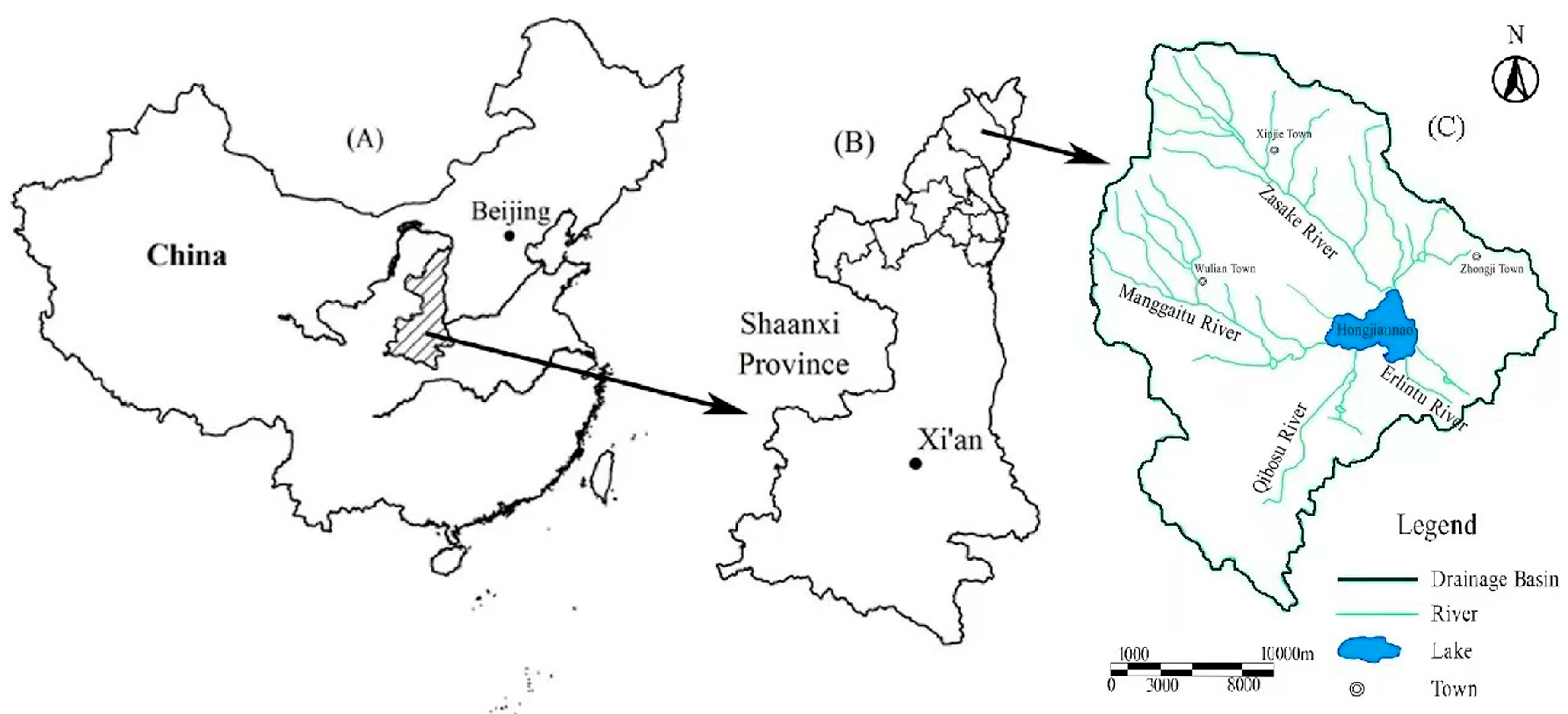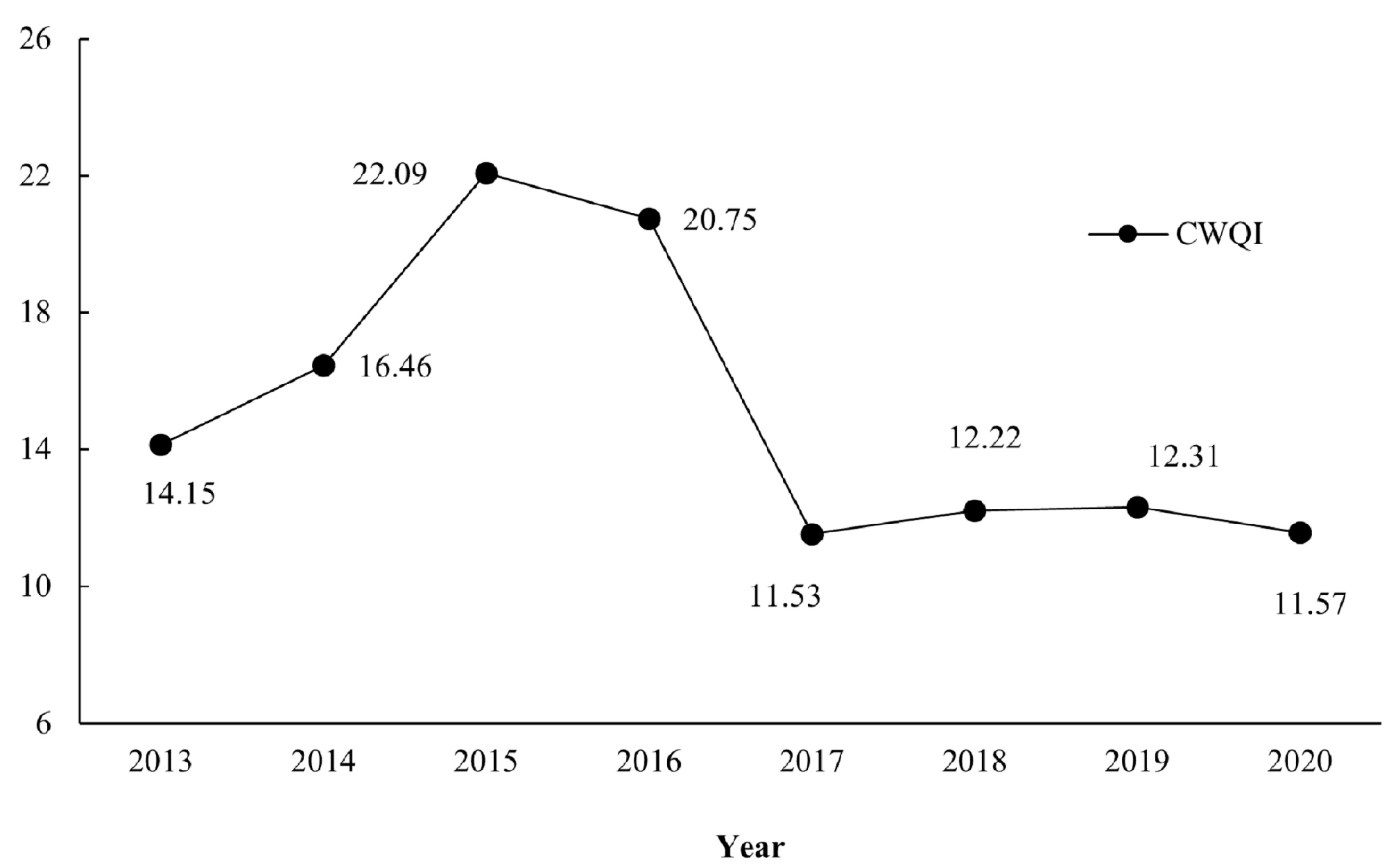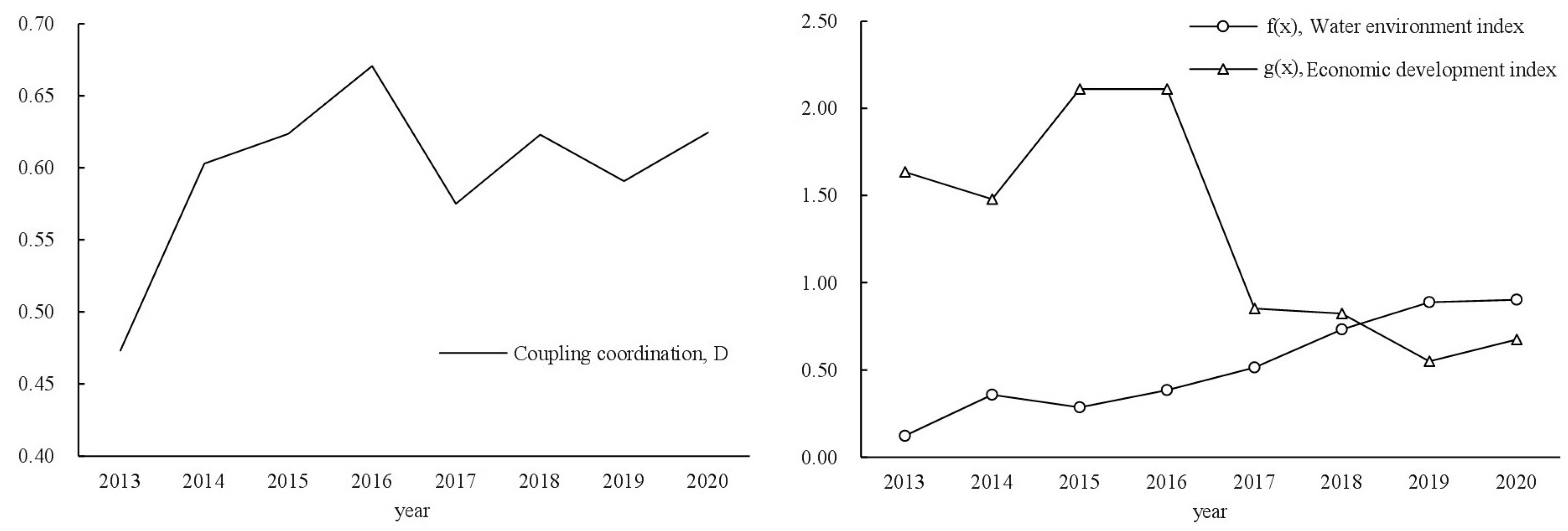Analysis of the Coupling Relationship between Water Quality and Economic Development in Hongjiannao Basin, China
Abstract
:1. Introduction
2. Methods and Materials
2.1. Study Area
2.2. Data Description
2.3. Characteristics of Water Quality Evolution
2.3.1. Seasonal Differences of Water Quality
2.3.2. Interannual Variation Trend of Water Quality
2.4. Coupling Model
2.4.1. Construction of Index System
2.4.2. Water Environment and Economic Development Index
2.4.3. Coupling Coordination
3. Results and Analysis
3.1. Variation of Water Quality
3.1.1. The Seasonal Variations in Water Quality
3.1.2. The Annual Variation of Water Quality
3.2. Coupling Coordination Analysis
3.2.1. Comprehensive Index Analysis
3.2.2. Change in Coupling Coordination Degree and Classification of Coupling Coordination Types
4. Discussion
4.1. Analysis of Seasonal Variation of Water Quality in Hongjiannao Lake
4.2. Interannual Variation Analysis of Hongjiannao Water Quality
4.3. Coupling Coordination Analysis of Hongjiannao Water Environment and Socio-Economic Development
5. Conclusions
- (1)
- The water quality of Hongjiannao in the summer was worse than that in the spring and autumn. And, the water quality of Hongjiannao behaved with an increasing tendency from 2013 to 2020.
- (2)
- The degree of coupling coordination in Hongjiannao Lake was at the middle level, and its level increased first, and then decreased, and finally raised again. From 2013 to 2020, the development of coupling coordination in Hongjiannao basin expired three steps: the lagging economic development, the primary coordination, and the lagging water environment.
- (3)
- It can be seen that under the influence of urbanization, industrialization, and extreme hot weather, lake water levels have fallen, pollution is serious, and water resources are stressed. Therefore, governments at all levels should increase investment and management of pollution control, reduce the discharge of untreated sewage into water bodies, and adopt membrane treatment and other technologies to improve the efficiency of recycled water recovery and realize the resource utilization of sewage, especially in China and other developing countries in the world. Economic development promotes the improvement of water quality, and a good water environment also provides a guarantee for sustainable economic development.
Author Contributions
Funding
Data Availability Statement
Conflicts of Interest
References
- Yang, G.; Ma, R.; Zhang, L.; Yao, S.; Zhang, M.; Zeng, H. Lake status, major problems and protection strategy in China. J. Lake Sci. 2010, 22, 799–810. [Google Scholar]
- Sellinger, C.E.; Stow, C.A.; Lamon, E.C.; Qian, S.S. Recent Water Level Declines in the Lake Michigan−Huron System. Environ. Sci. Technol. 2008, 42, 367. [Google Scholar] [CrossRef]
- Song, J.X.; Tang, B.; Zhang, J.L.; Dou, X.Y.; Liu, Q.; Shen, W.B. System dynamics simulation for optimal stream flow regulations under consideration of coordinated development of ecology and socio-economy in the Weihe River Basin, China. Ecol. Eng. 2018, 124, 51–68. [Google Scholar] [CrossRef]
- Cohen, J.E. Population growth and earth’s human carrying capacity. Science 1995, 269, 341–346. [Google Scholar] [CrossRef] [PubMed]
- Cao, H.; Han, L.; Liu, Z.; Li, L. Monitoring and driving force analysis of spatial and temporal change of water area of Hongjiannao Lake from 1973 to 2019. Ecol. Inform. 2021, 61, 101230. [Google Scholar] [CrossRef]
- García-Nieto, P.; García-Gonzalo, E.; Alonso-Fernández, J.; Díaz-Muñiz, C. Using evolutionary multivariate adaptive regression splines approach to evaluate the eutrophication in the Pozón de la Dolores lake (Northern Spain). Ecol. Eng. 2016, 94, 136. [Google Scholar] [CrossRef]
- Chang, J.; Zhang, E.; Liu, E.; Liu, H.; Yang, X. A 60-year historical record of polycyclic aromatic hydrocarbons (PAHs) pollution in lake sediment from Guangxi Province, Southern China. Anthropocene 2018, 24, 51–60. [Google Scholar] [CrossRef]
- Ioannides, K.; Stamoulis, K.; Papachristodoulou, C.; Tziamou, E.; Markantonaki, C.; Tsodoulos, I. Distribution of heavy metals in sediment cores of Lake Pamvotis (Greece): A pollution and potential risk assessment. Environ. Monit. Assess. 2014, 187, 4209. [Google Scholar] [CrossRef]
- Zhang, K.M.; Wen, Z.G. Review and challenges of policies of environmental protection and sustainable development in China. J. Environ. Manag. 2008, 88, 1249. [Google Scholar] [CrossRef] [PubMed]
- Joshi, A.; Seth, G. Hydrochemical profile for assessing the groundwater quality of Sambhar lake City and its Adjoining area. Environ. Monit. Assess. 2011, 174, 547. [Google Scholar] [CrossRef]
- Zhang, N.; Wu, T.; Wang, B.; Dong, L.; Ren, J.Z. Sustainable water resource and endogenous economic growth. Technol. Forecast. Soc. Chang. 2016, 112, 237–244. [Google Scholar] [CrossRef]
- Gao, W.; Chen, Y.; Xu, M.; Guo, H.C.; Xie, Y.C. Trend and driving factors of water quality change in Lake Fuxian (1980–2011). J. Lake Sci. 2013, 25, 635–642. [Google Scholar]
- Haken, H. Synergetics are cooperative phenomena governed by universal principles. Naturwissenschaften 1980, 67, 121. [Google Scholar] [CrossRef]
- Liu, N.N.; Liu, C.Z.; Xia, Y.F.; Da, B. Examining the coordination between urbanization and eco-environment using coupling and spatial analyses: A case study in China. Ecol. Indic. 2018, 93, 1163–1175. [Google Scholar] [CrossRef]
- Ouyang, X.; Shao, Q.; Zhu, X.; He, Q.; Xiang, C.; Wei, G. Environmental regulation, economic growth and air pollution: Panel threshold analysis for OECD countries. Sci. Total Environ. 2019, 657, 234–241. [Google Scholar] [CrossRef]
- Xie, Q.; Xu, X.; Liu, X. Is there an EKC between economic growth and smog pollution in China? New evidence from semiparametric spatial autoregressive models. J. Clean. Prod. 2019, 220, 873–883. [Google Scholar] [CrossRef]
- Isik, C.; Ongan, S.; Özdemir, D. The economic growth development and environmental degradation: Evidence from the US state-level EKC hypothesis. Environ. Sci. Pollut. Res. 2019, 26, 30772–30781. [Google Scholar] [CrossRef]
- Liu, L.; Qiu, X.; Zhang, M.; Li, Y. Main Environmental Impact of Coal Exploitation on Hongjiannao Lake and Protective Measures. Yellow River 2019, 41, 59–62. [Google Scholar]
- Jones, R.N.; McMahon, T.A.; Bowler, J.M. Modelling historical lake levels and recent climate change at three closed lakes, Western Victoria, Australia (c.1840–1990). J. Hydrol. 2001, 246, 159–180. [Google Scholar] [CrossRef]
- Tamm, T.; Tiina, N.; Arvo, J.; Faycal, B. Contributions of DOC from surface and groundflow into Lake Võrtsjärv (Estonia). Hydrobiologia 2008, 599, 213–220. [Google Scholar] [CrossRef]
- Ronchi, E.; Federico, A.; Musmeci, F. A system oriented integrated indicator for sustainable development in Italy. Ecol. Indic. 2002, 2, 197–210. [Google Scholar] [CrossRef]
- Zhang, S.; Zhang, L.; Li, G.; Li, C.; Wu, Z. Coordination analysis between water quality and economic development in Lake Qiandao basin. J. Lake Sci. 2014, 26, 948–954. [Google Scholar]
- Rao, Q.; Lin, X.; Li, J.; Chen, Q.; Chen, W. Analysis of coupling coordination between social economy and water environment quality in river basin. China Environ. Sci. 2019, 39, 1784–1792. [Google Scholar]
- Xu, G.C.; Cheng, Y.T.; Zhao, C.Z.; Mao, J.S.; Li, Z.B.; Jia, L.; Zhang, Y.X.; Wang, B. Effects of driving factors at multi-spatial scales on seasonal runoff and sediment changes. Catena 2023, 222, 106867. [Google Scholar] [CrossRef]
- Liu, X.J.; Zhang, Y.; Zhang, L.; Fang, X.M.; Deng, W.P.; Liu, Y.Q. Aggregate-associated soil organic carbon fractions in sub-tropical soil undergoing vegetative restoration. Land Degrad. Dev. 2023, 72, 446–459. [Google Scholar]
- Zhuo, J.; Zhu, Y.; Wang, J.; He, H.; Zou, J. Spatio-temporal Change of Water Area in Hongjiannao Lake and the Effectiveness of Protection Measures. J. Desert Res. 2019, 39, 195–203. [Google Scholar]
- Zhang, G.; Yao, T.; Chen, W.; Zheng, G.; Shum, C.K.; Yang, K.; Piao, S.; Sheng, Y.; Yi, S.; Li, J.; et al. Regional differences of lake evolution across China during 1960s–2015 and its natural and anthropogenic causes. Remote Sens. Environ. 2019, 221, 386–404. [Google Scholar] [CrossRef]
- Borsuk, M.E.; Stow, C.A.; Reckhow, K.H. A bayesian network of eutrophication modles for synthesis prediction and uncertainty analysis. Ecol. Model. 2004, 173, 219–239. [Google Scholar] [CrossRef]
- Zhao, M.; Xu, Y.; Zhang, C.; Rong, H.; Zeng, G. New trends in removing heavy metals from wastewater. Appl. Microbiol. Biotechnol. 2016, 100, 6509–6518. [Google Scholar] [CrossRef]
- Paer, H.W. Assessing and Managing Nutrient Enhanced Eutrophicationin Estuarine and Coastal Waters: Interactive Effects of Human and Climatic Perturbations. Ecol. Eng. 2006, 26, 40–54. [Google Scholar] [CrossRef]
- GB 3838-2002; Surface Water Environmental Quality Standards, China. 2002. Available online: https://www.mee.gov.cn/ywgz/fgbz/bz/bzwb/shjbh/shjzlbz/200206/t20020601_66497.shtml (accessed on 12 February 2022).
- Zhang, G.; Christensen, R.; Pesko, J. Parametric boostrap and objective Bayesian testing for heteroscedastic one-way ANOVA. Stat. Probab. Lett. 2021, 174, 109095. [Google Scholar] [CrossRef]
- Das, S.; Banerjee, S. Investigation of changes in seasonal streamflow and sediment load in the Subarnarekha-Burhabalang basins using Mann-Kendall and Pettitt tests. Arab. J. Geosci. 2021, 14, 946. [Google Scholar] [CrossRef]
- Xin, Z. Study on the Water Environment of Larus Relictus Nature Reserve in Erdos Plateau. Ph.D. Thesis, Beijing Forestry University, Beijing, China, 2015. (In Chinese). [Google Scholar]
- Yang, H.; Zhong, Y.; Luo, L.; Tian, X.; Wang, Z. Water Quality Evaluation and Characteristics Analysis of Xinghai Lake Wetland Based on Bayesian Method. Water Sav. Irrig. 2018, 4, 92–95. [Google Scholar]
- Wang, Q.; Su, M. The effects of urbanization and industrialization on decoupling economic growth from carbon emission—A case study of China. Sustain. Cities Soc. 2019, 51, 101758. [Google Scholar] [CrossRef]
- Labhasetwar, P.K.; Yadav, A. Membrane Based Point-of-Use Drinking Water Treatment Systems; IWA Publishing: London, UK, 2023. [Google Scholar]




| System | Sub-System | Indexes | Weight of Coefficient |
|---|---|---|---|
| Social-economic development | Economic structure | X1 | 0.0294 |
| X2 | 0.0084 | ||
| X3 | 0.0237 | ||
| X4 | 0.0020 | ||
| Economic benefit | X5 | 0.0350 | |
| X6 | 0.0431 | ||
| X7 | 0.0403 | ||
| X8 | 0.0591 | ||
| X9 | 0.0709 | ||
| X10 | 0.0581 | ||
| X11 | 0.0216 | ||
| X12 | 0.0241 | ||
| Water environment | Water indexes | Y1 | 0.0132 |
| Y2 | 0.0423 | ||
| Y3 | 0.1058 | ||
| Y4 | 0.1086 | ||
| Y5 | 0.0782 | ||
| Y6 | 0.1856 | ||
| Y7 | 0.1906 | ||
| Y8 | 0.0666 | ||
| Y9 | 0.0848 | ||
| Y10 | 0.1243 |
| Types | Sub-Types | Form | State | ||
|---|---|---|---|---|---|
| Coordination period | 0.6 < D ≤ 1 | High coordination | 0.8 < D ≤ 1 | f(x) − g(x) > 0.1 | lagging economic development |
| g(x) − f(x) > 0.1 | Lagging water environment | ||||
| 0 ≤ |f(x) − g(x)| ≤ 0.1 | |||||
| Intermediate coordination | 0.7 < D ≤ 0.8 | f(x) − g(x) > 0.1 | lagging economic development | ||
| g(x) − f(x) > 0.1 | Lagging water environment | ||||
| 0 ≤ |f(x) − g(x)| ≤0.1 | |||||
| Primary coordination | 0.6 < D ≤ 0.7 | f(x) − g(x) > 0.1 | lagging economic development | ||
| g(x) − f(x) > 0.1 | Lagging water environment | ||||
| 0 ≤ |f(x) − g(x)| ≤ 0.1 | |||||
| Transformation period | 0.4 < D ≤ 0.6 | Barely coordination | 0.5 < D ≤ 0.6 | f(x) − g(x) > 0.1 | lagging economic development |
| g(x) − f(x) > 0.1 | Lagging water environment | ||||
| 0 ≤ |f(x) − g(x)| ≤ 0.1 | |||||
| Nearly un-coordination | 0.4 < D ≤ 0.5 | f(x) − g(x) > 0.1 | lagging economic development | ||
| g(x) − f(x) > 0.1 | Lagging water environment | ||||
| 0 ≤ |f(x) − g(x) | ≤ 0.1 | |||||
| Un-coordination | 0 <D ≤ 0.4 | Slight un-coordination | 0.3 < D ≤ 0.4 | f(x) − g(x) > 0.1 | lagging economic development |
| g(x) − f(x) > 0.1 | Lagging water environment | ||||
| 0 ≤ |f(x) − g(x)| ≤ 0.1 | |||||
| Intermediate un-coordination | 0.2 < D ≤ 0.3 | f(x) − g(x) > 0.1 | lagging economic development | ||
| g(x) − f(x) > 0.1 | Lagging water environment | ||||
| 0 ≤ |f(x) − g(x)| ≤ 0.1 | |||||
| Serious un-coordination | 0 < D ≤ 0.2 | f(x) − g(x) > 0.1 | lagging economic development | ||
| g(x) − f(x) > 0.1 | Lagging water environment | ||||
| 0 ≤ |f(x) − g(x) | ≤ 0.1 | |||||
| Season | DO/ mg·L−1 | CODMn/ mg·L−1 | BOD5/ mg·L−1 | NH3-N/ mg·L−1 | TN/ mg·L−1 | TP/mg·L−1 | Volatile Phenol/ mg·L−1 | CODCr/ mg·L−1 | Petroleum/ mg·L−1 | Anionic Surfactant/ mg·L−1 |
|---|---|---|---|---|---|---|---|---|---|---|
| Spring | 8.317 a | 12.429 a | 2.586 a | 0.351 a | 3.381 a | 0.089 a | 0.009 a | 43.143 a | 0.038 a | 0.050 a |
| Summer | 7.424 b | 12.664 a | 3.275 a | 0.375 a | 3.468 a | 0.091 a | 0.011 a | 45.084 a | 0.043 a | 0.065 a |
| Autumn | 8.384 c | 12.844 a | 1.718 b | 0.268 a | 2.740 a | 0.085 a | 0.009 a | 44.118 a | 0.038 a | 0.059 a |
| DO /mg·L−1 | CODMn /mg·L−1 | BOD5 /mg·L−1 | NH3-N /mg·L−1 | TN /mg·L−1 | TP /mg·L−1 | Volatile Phenol /mg·L−1 | CODCr /mg·L−1 | Petroleum Ether/mg·L−1 | Anionic Surfactant/mg·L−1 | |
|---|---|---|---|---|---|---|---|---|---|---|
| Value of Daniel test | −0.167 | −0.667 | −0.595 | −0.809 ** | 0.048 | −0.095 | −0.643 * | 0.214 | −0.155 | −1.107 ** |
| Value of Mann–Kendall test | −0.371 | −1.608 | −1.361 | −2.103 * | 0.000 | −0.619 | −1.361 | 0.124 | −0.742 | −2.969 ** |
| Changeable tendency | Down | Down | Down | Down | Up | Down | Down | Up | Down | Down |
| Year | Coupling Coordination | Types | |
|---|---|---|---|
| 2013 | 0.473 | Transformation period | Nearly un-coordination—lagging economic development |
| 2014 | 0.603 | Coordination period | Primary coordination—lagging economic development |
| 2015 | 0.623 | Coordination period | Primary coordination—lagging economic development |
| 2016 | 0.671 | Coordination period | Primary coordination—lagging economic development |
| 2017 | 0.575 | Transformation period | Barely coordination—lagging economic development |
| 2018 | 0.623 | Coordination period | Primary coupling |
| 2019 | 0.591 | Transformation period | Barely coordination—lagging water environment |
| 2020 | 0.624 | Coordination period | Primary coupling—lagging water environment |
Disclaimer/Publisher’s Note: The statements, opinions and data contained in all publications are solely those of the individual author(s) and contributor(s) and not of MDPI and/or the editor(s). MDPI and/or the editor(s) disclaim responsibility for any injury to people or property resulting from any ideas, methods, instructions or products referred to in the content. |
© 2023 by the authors. Licensee MDPI, Basel, Switzerland. This article is an open access article distributed under the terms and conditions of the Creative Commons Attribution (CC BY) license (https://creativecommons.org/licenses/by/4.0/).
Share and Cite
Liu, X.; Cheng, S.; Miao, Z.; Li, Z.; Li, P.; Liu, T.; Zhi, H.; Zhang, S.; Wang, Y.; Zheng, X. Analysis of the Coupling Relationship between Water Quality and Economic Development in Hongjiannao Basin, China. Water 2023, 15, 2965. https://doi.org/10.3390/w15162965
Liu X, Cheng S, Miao Z, Li Z, Li P, Liu T, Zhi H, Zhang S, Wang Y, Zheng X. Analysis of the Coupling Relationship between Water Quality and Economic Development in Hongjiannao Basin, China. Water. 2023; 15(16):2965. https://doi.org/10.3390/w15162965
Chicago/Turabian StyleLiu, Xiaoping, Shengdong Cheng, Ziyao Miao, Zhanbin Li, Peng Li, Tong Liu, Hegang Zhi, Shen Zhang, Yifan Wang, and Xing Zheng. 2023. "Analysis of the Coupling Relationship between Water Quality and Economic Development in Hongjiannao Basin, China" Water 15, no. 16: 2965. https://doi.org/10.3390/w15162965
APA StyleLiu, X., Cheng, S., Miao, Z., Li, Z., Li, P., Liu, T., Zhi, H., Zhang, S., Wang, Y., & Zheng, X. (2023). Analysis of the Coupling Relationship between Water Quality and Economic Development in Hongjiannao Basin, China. Water, 15(16), 2965. https://doi.org/10.3390/w15162965







